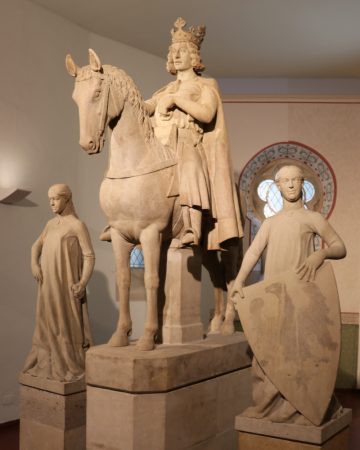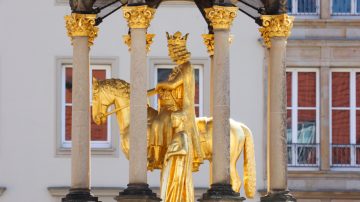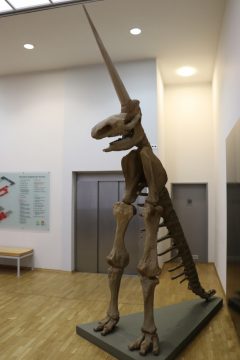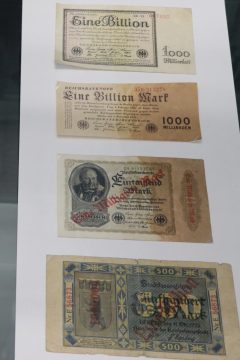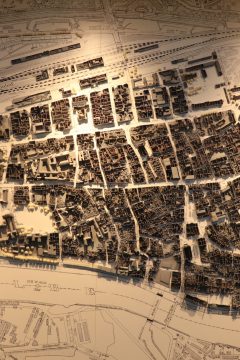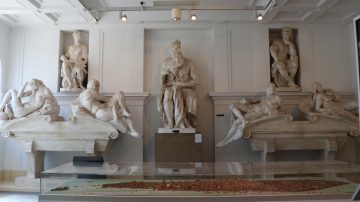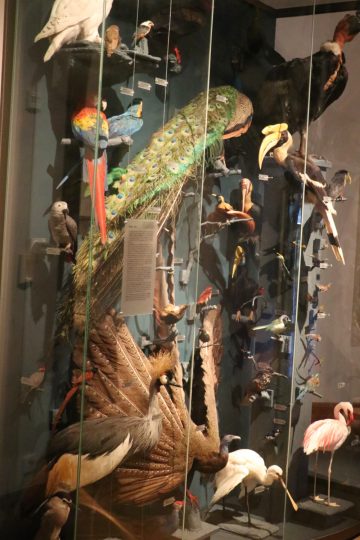The original medieval Magdeburger Reiter equestrian sculpture is the main attraction in the Kunsthistorisches Museum (art and history) in Magdeburg, Germany.
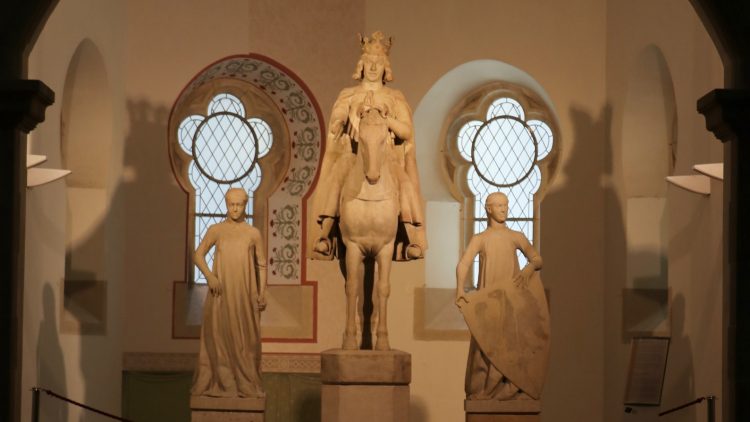
The original mid-13th-century Magdeburger Reiter (Magdeburg Rider, also Horseman of Magdeburg) is the main attraction of the Kunsthistorisches Museum. Further exhibits in this small local history and art museum include paintings by Lucas Cranach, a variety of items on the long history of Magdeburg, and locally produced items. A School Museum is a permanent collection on education in the region with special emphasis on the East German period. Admission to the museum also includes the small Naturkunde Museum (Natural History), which has several interesting exhibitions at least worth a quick glance. The museum often has excellent special temporary exhibitions that attract day-trippers and visitors from the region and Berlin.
Magdeburger Reiter in the Kunsthistorisches Museum
The original mid-13th-century Magdeburger Reiter is the main attraction of the small Kunsthistorisches Museum. This equestrian statue with a regal rider accompanied by two females is presented in the Kaiser Otto Saal (Emperor Otto Hall), in the recently restored early twentieth-century museum building.
The Magdeburger Reiter was produced around 1240, as the first large freestanding equestrian statue since classical antiquity and the first such work made north of the Alps. This work consists of around a hundred sandstone pieces. The rider is almost certainly a depiction of Emperor Otto I the Great while the two maidens carry imperial insignia.
The sculpture was displayed on the market in Magdeburg from the mid-13th century until the 1960s when it was moved into the museum. A gilded bronze copy is now on the market square.
See The Magdeburger Reiter (Magdeburg Rider) Equestrian Statue for more on this important artwork and Otto’s links to Magdeburg.
In the same hall are three large paintings by Arthur Kampf (1905/6) depicting events from the long reign of Otto. Also on display is a large Baroque Weihnachtskrippe (nativity scene) that was recently restored.
Top Art in the Kunsthistorisches Museum
The art inside the museum and in its name is not to use an all-inclusive term to cover all possible paintings of local mayors or notables long since forgotten, although there certainly are some of those, but the museum has very high quality works too.
The museum has paintings from the 1500s to the present but the best-known works are two oil paintings by Lucas Cranach: an Adam and Eve and Mary with baby and John (the Baptist) as child.
Much of the painting collection was lost during the Second World War and from Soviet looting afterward. The most famous painting lost is Der Maler auf dem Weg nach Tarascon by Vincent Van Gogh. It was never conclusively proven whether this well-known and influential work by Van Gogh was destroyed by fire or looted after the war. It remains on many lists of missing artworks.
Further Sights in the Local History Museum in Magdeburg
As is often the case with local history museums in towns now much smaller than their historical roles warrant, many further treasures may be discovered in the collection. Although Magdeburg had a reputation as the greyest of grey cities during the East German period, and its present population of 240,000 seems to be on a downward spiral, it was during the middle ages one of the largest and most important cities in Germany.
As a local history museum, it of course has much on the development of Magdeburg including the typical models of the city, e.g. before and after the Thirty Years’ War and the Second World War, items produced locally, and local notables that included not only Otto I but also Otto von Guericke, a pioneer in the physics of the vacuum and atmospheric pressure. The museum also has a large collection of high-quality local silverware, furniture, tapestries, textiles, and faience.
A more unusual item is a unicorn skeleton produced in 2001 after sketches made by Gottfried Wilhelm Leibniz in 1749. Otto von Guericke identified Ice Age bones and fossils found in a local quarry in 1663, as belonging to a unicorn. It is hard to determine whether he (or Leibniz) was serious about it or having a laugh.
Further treasures on display include high-quality bronze biblical scenes from the doors of Plock or Novgorod cathedral and copies of religious codexes from the Evangeliar Heinrichs des Löwen (around 1188)
Like any self-respecting German history museum, it has banknotes from the hyperinflation period of the early 1920s, including a Billion Mark note (i.e. a million million marks).
Enter another room and come face to face with full-size plaster casts of Michelangelo’s Moses from San Pietro in Vincoli in Rome and the equally famous sculptures from the Medici grave chapel in Florence.
A small School Museum focuses mostly on education in the German Democratic Republic period although foreign visitors might be more fascinated by the school books to teach reading and writing during the 1930s including swastikas and useful phrases such as “heil”.
Museum für Naturkunde in Magdeburg
Admission to the local history museum also includes the Museum für Naturkunde (Natural History Museum) which is in the same building. Although the collection includes around 350,000 items, only a fraction is on display.
Some of the collections are highly praised by specialists but most visitors will simply enjoy a walk-through and peek into the various glass display cases. While the German descriptions are often very thorough, the use of English is sparse. The main permanent collections are grouped in the wonder of life, the environment of Saxony-Anhalt, and the Ice Age.
The “Wonder of Life” exhibition consists of around 1400 items and explains the major events of life on earth and stages of evolution. Displays include fossils, models, and reconstructions with a few interactive stations. Further large cases include a variety of taxidermy displays, skeletons, and a very large collection of insects and small marine animals.
Museum Visitors Information
Admission to the museum (including the art-history and natural history museums) is €5 (free for under 18) but is often more when large special exhibitions are on display in the history museum.
Present the museum ticket within 30 days for discounted admission to the Kunstmuseum Kloster Unser Lieben Frauen and the Dommuseum Ottonianum Magdeburg.
Opening hours are usually Tuesday to Friday from 10:00 to 17:00 and weekends from 10:00 to 18:00. The museums are open on many holidays.
The museum is a few short blocks to the west of the Dom zu Magdeburg, the first Gothic cathedral built in Germany.
Magdeburg hotels (see Tripadvisor ratings) often offer good deals over weekends and during holiday periods when business and political visits are less common. Very good transportation links — see German Railways timetables — make Magdeburg a good base for sightseeing in the region.
